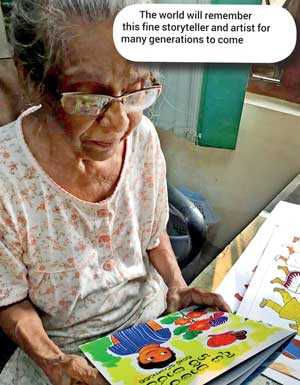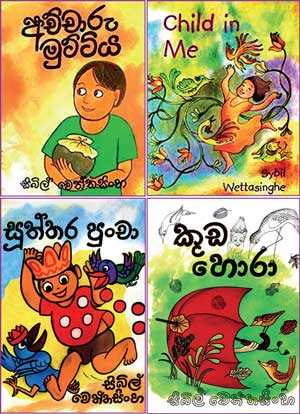Saturday Dec 13, 2025
Saturday Dec 13, 2025
Saturday, 4 July 2020 00:02 - - {{hitsCtrl.values.hits}}
 By Deepal Sooriyaarachchi
By Deepal Sooriyaarachchi
A few months back she illustrated my book ‘Diya Paren Hari Parata,’ a book for children written using a stanza from the ‘Dhammapada,’ introducing the concept of mindfulness to kids through a story. On completion of the book she said: “Aney, puthe let us do a Dhammapada for children and I want to do that before I die, I will do all the illustrations.”
It was such a powerful persuasion and I went back to work though it was a big challenge. Having selected about 50 stanzas that can be relevant to children I wrote some further explanations and some activities to drive the point home. Sybil was thrilled, at one go she did unusual sketches for all of them. They were different to any of her standard work, they were more abstract and some were with unbroken single lines.
We discussed at length what the cover should be and I wanted to portray a Buddha who is in conversation with children. She loved the idea and what came out is an absolutely a masterpiece. Having done all the drawings she said: “I don’t know how I drew these, I just started and they happened as if a super power was directing me.”
I know it was such a fulfilling project for her. If not for the corona lockdown we would have finished the book to launch for Vesak. But I know she will be with those angels floating in the air as she used to dream and live on earth by the time we complete printing of the book and launching it. Till then happy times, Sybil Nenda!
Sybil’s drawings are so unique. They are like live shots taken from an animated movie. Whether it is a flower, tree, a cloud, or a bird, all of them had life. They spoke with the reader as much as they communicated with her in her dreams.
She thought like a child
Self-taught artist Sybil sometimes knew how the children think even better than some of the child psychologists. I think she had that sensitivity because she thought like a child. Her concepts were so simple but had the power to grab the imagination of a child. Only a child can think that way.
She was very sensitive not only the message but the impact it can have on children. The work she has done to educate children on subjects that are difficult such as abuse, drugs, and rights are such clever pieces of work and they need even broader circulation and appreciation.
She was full of energy till the last day. In afternoons when many seniors would enjoy a siesta Sybil would be drawing or writing at her desk, totally immersed in her work.
She had completed a series of paintings on the life of Buddha which should be reproduced like the famous paintings by Sarlis that adorned many traditional Buddhist homes. They were such fine work with so many details.
‘The Child in Me’
 Sybil must be every person’s ideal way to grow old – that is to never grow old in your thinking. She was so much full of life and imagination that only a kid can do. She reveals this in her own words in ‘The Child in Me’ (1995):
Sybil must be every person’s ideal way to grow old – that is to never grow old in your thinking. She was so much full of life and imagination that only a kid can do. She reveals this in her own words in ‘The Child in Me’ (1995):
“My childhood I lived in a wonderland of birds that spoke and flowers that sang.
The swirling winds around me danced holding the hands with me in a trance.
Sometimes the moon dropped down the stars to keep me happy through the nights.
Those enchanting dreams are still alive in some part of my mind, here lives the child.
A wonder child lives in all of us in deep sweet slumber but is often lost.
Awaken those charms for a while anew amidst the weary ageing strains.
The dream child in you will sooth your pains.”
This is indeed a very powerful message, the message to the world that even kids are made to lose their childhood. See the variety of reality shows where we make adults out of our children, making them do what we adults think is “sweet” and “cute”. By our adult dreams we spoil the spontaneous charm of children.
One famous person who lamented losing the childhood is the best-known pop artist of the last century, Michael Jackson. He revealed this when he addressed the audience at the Oxford University.
“Tonight, I come before you less as an icon of pop (whatever that means anyway), and more as an icon of a generation, a generation that no longer knows what it means to be children.
“All of us are products of our childhood. But I am the product of a lack of a childhood, an absence of that precious and wondrous age when we frolic playfully without a care in the world, basking in the adoration of parents and relatives, where our biggest concern is studying for that big spelling test come Monday morning.
“Those of you who are familiar with the Jackson Five know that I began performing at the tender age of five and that ever since then, I haven’t stopped dancing or singing. But while performing and making music undoubtedly remain as some of my greatest joys, when I was young I wanted more than anything else to be a typical little boy. I wanted to build tree houses, have water balloon fights, and play hide and seek with my friends. But fate had it otherwise and all I could do was envy the laughter and playtime that seemed to be going on all around me.”
The life and works of Cybil must be appreciated in this type of society we live today where adults rob the innocence of children in many ways, some being so selfish and cruel.
Sybil the Safety Ambassador
Although I had read books by Sybil when I was young, my fascination about Sybil’s work started only after reading her series ‘Sutthara Puncha’ in Silumina in the eighties. I read the story on Sunday. But was looking forward to the retelling of this story by one of our bus mates. She really gave life to the story. Those were the times prior to TV, prior to privatisation of buses, so we had fun while travelling. Later I met Sybil when I was in advertising at de Alwis, where she was commissioned to write a children’s book to educate on the topic of coast conservation.
Later when I joined Eagle Insurance (now AIA) we selected promoting safety as the platform of our CSR focus. Well, this was before the word CSR was in vogue. Our corporate payoff line was ‘come under our wings and we care for your protection’. Hence promoting safety was just right for us.
Having observed some international work on similar themes, Chandra Jayaratne, then Planning Director, came up with the idea of doing a children’s book as a way to promote safety at home. The obvious choice was Sybil. She was thrilled with the idea and without any briefing she came up with a beautiful nursery rhymes book called ‘Punchi Lamai Rattaran’.
The book had those lively illustrations of Sybil with apt poems. She had very cleverly interwoven the emblem of the company Eagle as the wise person who reminds kids about the dangers depicted in the scene.
National level poster exhibition
The book opened many extensions to our program. We organised a national level poster exhibition. It attracted entries from all four corners of the country. Our intention was to take the discussion about safety to every household. Sybil was a permanent member of our eminent panel of judges.
I remember how once she selected a poster by a girl from Kandy who had drawn a group of kids playing the railway around an unprotected well with the title ‘Kochchiyak Lindata Wetei’. Later she became an award-winning designer. Sybil’s eye for talent was such.
Inspired by the book we started a series of regional events. We invited hundreds of school children to a common place, got Sybil to relate a story. The kids would listen to her as if they were mesmerised by her animation of the characters and scenes. Then the kids were given a chance to draw a picture based on the story. Until the kids finished drawing we would conduct a seminar for the parents on safety. At the end while Sybil went through the paintings to select the better ones, we would distribute copies of the books to the kids and sing the nursery rhymes from ‘Punchi Lamai Rattaran’ with them. At the end of judging Sybil tells the kids why some paintings were more interesting than others without hurting the kids. Of course every child got a gift, not only those who drew better. We would have reached tens of thousands of kids with Sybil through this program.
I had the privilege of accompanying Sybil on most of those trips, along with my wife as well. It was such a treat to go with her. From the moment she gets into the car, the longer the journey, the more we rejoiced. She would tell one story after another and we were fascinated as much as kids would be. She never gets tired by telling stories. A living example of being passionate.
Inculcating safety habits among kids
One day I got a telephone call from a Montessori teacher from Moratuwa. She wanted to show us a video of the concert of her preschool. The whole concert was a theatrical reproduction of ‘Punchi Lamai Rattaran’. This was a result of the islandwide preschool seminars we conducted to educate the preschool teachers on the importance of inculcating safety habits among kids.
New Year time always sees an increase in accidents, mostly involving kids. What better way to take the need to be safe during festive season than asking Sybil to do a new kind of a New Year litha (almanac) targeting children? It was so effective we reproduced the same ad for many years.
The success of the first book ‘Punchi Lamai Rattaran’ was overwhelming and we decided to do a second book and to translate both books into English and Tamil as well. The second book was ‘Mallitai Matai’. That too had the same appeal.
Later on another year Sybil was presented with the coveted Eagle Award of Excellence, reserved only for those Sri Lankans who have excelled in their chosen field.
Sybil’s partnership in our efforts to promote safety perhaps can be considered one of the most comprehensive engagements with any cause, using her talent extensively. Once she told me the books she did with Eagle were the ones that were distributed most across the country.
Sybil is one of the very few Sri Lankan authors who have earned international repute. Her works are translated into a number of languages, including Japanese. The world will remember this fine storyteller and artist for many generations to come.
Enjoy the journey, Sybil Nenda.